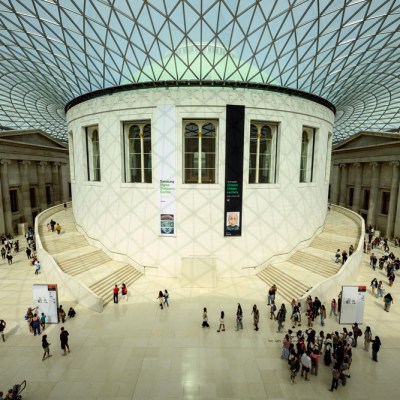Introducing Rakewell, Apollo’s wandering eye on the art world. Look out for regular posts taking a rakish perspective on art and museum stories.
Such is the British Museum’s mastery of public relations that its last major announcement of 2023, on 19 December, came not from the institution itself, but via a flurry of press releases from climate-action groups revealing that the troubled institution had renewed its sponsorship deal with BP for another ten years. No surprise there, BM-watchers might say, but what a terrible way to end a terrible year. The press release that the museum quietly deposited on its website presented this remarkable own goal as ‘British Museum sets out next steps for Masterplan’, mysteriously tying the headline news about BP not just to the funding of infrastructure works but to the issue of free entry.
After some excellent digging by the Art Newspaper, it became clear that this really was a case of trying to bury bad news while everyone was hopped up on eggnog. The delayed publication of the minutes of trustees’ meetings in the second half of the year revealed that in late June there was ‘strong personal disagreement about accepting money from companies in the sponsor’s line of business’. In November, this had progressed to Muriel Gray, a former deputy chair of trustees, resigning from the board. We also learn that there were questions about ‘the personal safety of staff and trustees, and the impact an announcement might have on the museum’s staff’. With the minutes from the final trustees’ meeting of 2023 still to be published, Rakewell is looking forward to finding out how these concerns were addressed.
Rakewell has no time for contrarianism, but would like to put moral questions aside for a moment and focus, once again, on just how poorly the British Museum is led. For what really strikes your roving correspondent is what a terrible deal the announcement represents. Fifty million pounds over ten years – from BP? Last autumn, the energy company reported underlying profits of $3.3bn (and this came as a disappointment after record profits the previous year). In December, the Financial Times reported that BP was to make its sacked former chief executive Bernard Looney forfeit up to £32.4m, mainly in the form of shares. It’s hard to see that the oil and gas giant is going to miss £5m a year over the course of a decade. We are not suggesting that £500m, say, would make fossil fuel money morally acceptable – but opportunities for reputation-laundering shouldn’t be available at such bargain-basement prices. And it would be much harder to make the case against taking the money and running. The reputational damage to an already-damaged British Museum, however, can only grow. It’s remarkable that the decision was made while a permanent director is still to be appointed and the search hasn’t even begun; not officially, that is. It’s also hard to see why the best candidates for a near-impossible job should apply to have their hands tied by an all-powerful chair.
Still, perhaps the British Museum and the former Anglo-Persian Oil Company are closer in ethos than is usually supposed. Rakewell finds the assumption that everything in the BM is looted lazy and uninteresting. But the formation of much of the collection, particularly in the 19th and early 20th centuries, is undeniably connected to Britain’s place in the world, with all that entails regarding imperial networks and imperial injustices. From its founding in 1909, the Anglo-Persian Oil Company, later BP, was majority-owned by the British government until it was privatised in stages by successive Thatcher governments between 1979 and 1987. (A short-lived attempt by Iran to nationalise the company led to Britain and the United States toppling a democratically elected Iranian government in 1953.) Both institutions have a lot to think about when it comes to restitution, reputation and reparations. Let’s hope they spend the next decade wisely.
Got a story for Rakewell? Get in touch at rakewell@apollomag.com or via @Rakewelltweets.




